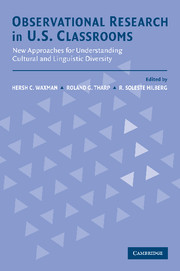 Observational Research in U.S. Classrooms
Observational Research in U.S. Classrooms Published online by Cambridge University Press: 23 November 2009
This chapter summarizes the work presented in the book, reviews some of the ways classroom observation has contributed to the research knowledge in the field of teacher effectiveness, and discusses some of the important implications of the book for the improvement of teaching and student learning in culturally diverse settings. Some of the criticisms and cautions related to the use of structured observation and techniques are also summarized. Finally, some future directions for observational research are reported and three specific views are described: (a) using instruments that reflect best practices or educational standards, (b) instruments that focus on student behaviors as well as teachers, and (c) combining qualitative and quantitative methods in observation instruments.
LIMITATIONS OF SYSTEMATIC CLASSROOM OBSERVATION
Although previous chapters have highlighted some of the important purposes of classroom observation, there have also been several criticisms and cautions related to the use of structured observation techniques (Delamont & Hamilton, 1986; Evertson & Green, 1986; Galton, 1988; McIntyre & Macleod, 1986). The criticisms and limitations of using structured observation techniques are categorized into three subsections: (a) Theoretical and Epistemological Criticisms, (b) Methodological Concerns, and (c) Pragmatic Concerns. This section also includes a brief discussion of the implications of classroom observation and some future directions.
Theoretical and Epistemological Criticisms
Although observational research has produced a substantial body of important findings that can lead to improved teaching practices, there is still a lack of consensus or lack of confidence regarding the research (Nuthall & Alton-Lee, 1990).
To save this book to your Kindle, first ensure [email protected] is added to your Approved Personal Document E-mail List under your Personal Document Settings on the Manage Your Content and Devices page of your Amazon account. Then enter the ‘name’ part of your Kindle email address below. Find out more about saving to your Kindle.
Note you can select to save to either the @free.kindle.com or @kindle.com variations. ‘@free.kindle.com’ emails are free but can only be saved to your device when it is connected to wi-fi. ‘@kindle.com’ emails can be delivered even when you are not connected to wi-fi, but note that service fees apply.
Find out more about the Kindle Personal Document Service.
To save content items to your account, please confirm that you agree to abide by our usage policies. If this is the first time you use this feature, you will be asked to authorise Cambridge Core to connect with your account. Find out more about saving content to Dropbox.
To save content items to your account, please confirm that you agree to abide by our usage policies. If this is the first time you use this feature, you will be asked to authorise Cambridge Core to connect with your account. Find out more about saving content to Google Drive.